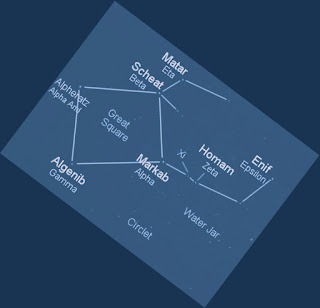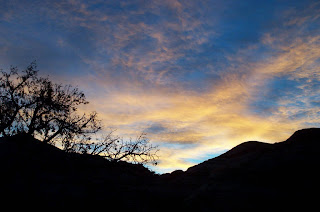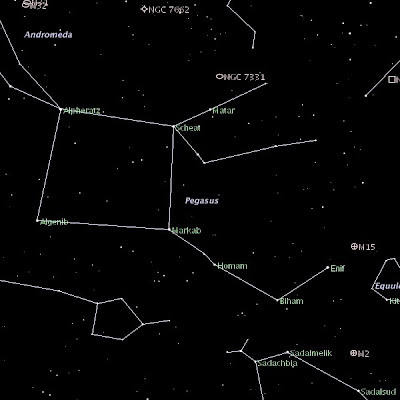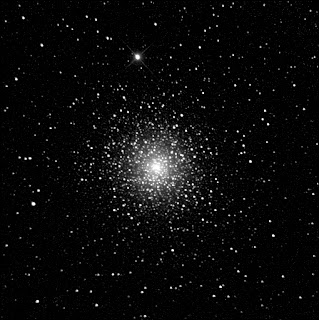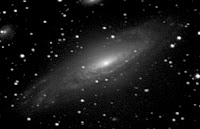
In legend, the beautiful but beleaguered Cassiopeia (pronounced kass ee oh PEE yuh) was the queen of ancient Ethiopia. She was the wife of King Cepheus (pronounced SEE fee yuss) and the mother of Andromeda. The queen’s vanity was her undoing. She rashly boasted that she was more beautiful than the sea nymphs. The miffed ocean-dwelling goddesses, fifty in number, appealed to their protector, the sea god Poseidon. He retaliated by sending the sea monster Cetus to ravage Ethiopia’s coast. Consulting an oracle for guidance, King Cepheus learned that he had to sacrifice daughter Andromeda to the monster in order to appease the angry god. That is how Andromeda came to be chained to a rock by the sea, waiting for her nick-of-time deliverance by the hero Perseus.
 Andromeda and sea monster by Domenico Guidi
Andromeda and sea monster by Domenico Guidiin the Metropolitan Museum of Art, NYC
The Lazy W’s bold, connect-the-dots pattern makes it easy for us to see why Cassiopeia is one of the oldest constellations, known to numerous ancient cultures and mentioned in Greek literature of the 5th century BCE. Known to the early Arabs as “The Lady in the Chair,” she is usually depicted sitting on a throne. But the gods had the last laugh. They placed the self-absorbed royal in the sky such that she spends half of her time upside down, a most undignified position for a queen.
 Cassiopeia, still primping, in an 18th century star atlas
Cassiopeia, still primping, in an 18th century star atlasImage courtesy of G.M. Caglieris
The astronomical explanation for Cassiopeia’s topsy-turvy existence has to do with it being a circumpolar constellation. In the Northern Hemisphere, a circumpolar constellation is a constellation that circles the North Celestial Pole, the imaginary fixed point in the sky that the Earth's axis would intersect, were it extended northward. This imaginary point just happens to be extremely close to the star Polaris, which is why we call Polaris the North Star.
In latitudes above 35 degrees north, circumpolar constellations never set; they are always above the horizon as they endlessly circle the North Star counterclockwise, making one revolution per day. But although we commonly say they are "circling," constellations like Cassiopeia are not really moving around the Pole. Their apparent motion--or the way they appear to move in our sky--is actually caused by our rotation, as planet Earth reliably spins 24/7 on its axis.
Let’s go outside and take a gander at the Queen Mum, shall we?
1) You’ll need to know where north is. If you don’t have a compass, take note of where the sun sets, which is approximately west. Stand with your left shoulder to the west, and you will be facing approximately north.
2) Wait at least one hour after sunset to begin observing. The waning (shrinking) moon won’t rise until at least three to four hours after sunset on Thursday the 27th, and then later each night as the week progresses. This late-rising moon will give you plenty of time to observe under dark skies.
3) Face north and tilt your head all the way back until you are looking at the zenith, the point in the sky that is directly above your head. Then slowly lower your head around one-quarter to one-third of the way down toward the northern horizon, until you spot a sprawling “M” pattern in the sky. This is the Lazy W of Cassiopeia, but it will be upside down because it is in mid-revolution around the North Star. If you were to go out just before dawn and look at it, you would notice that it had swung down closer to the horizon and had flipped over to its W orientation.

4) The five stars of the Lazy W asterism are the five brightest stars in Cassiopeia, so let’s take a closer look at them. Moving from left to right in the M orientation, the first star in the pattern is Caph (pronounced KAFF), which means the stained hand in Arabic, a reference to the ancient practice of body painting with henna, a plant dye. The second star is the orange giant Shedar or Schedar (pronounced SHEDD er), Arabic for breast, marking the position of the queen’s heart. The middle star of the asterism, a rapidly spinning blue star, is commonly known as Navi (pronounced NAHV ee), a modern name given it by Apollo astronaut Gus Grissom and the reverse spelling of Ivan, his middle name. The fourth star in the pattern is Ruchbah (pronounced ROOK buh), which means knee in Arabic. As it is nearly 100 light years away, we are looking at century-old light when we gaze at Ruchbah. The fifth star, Segin (pronounced segg EEN), is about seven times the size of our Sun and much older. Its name is of unknown origin.
5) Naked-Eye Challenge for a dark-sky site: Can you see the winter Milky Way winding behind Cassiopeia? It looks like a long, filmy cloud stretching across the sky from the northwestern to the southeastern horizons. On the star map above, it is shown as a gray swirling band. This is the Perseus arm of the Milky Way. At 6000 light years away, it is the closest spiral arm of the Milky Way galaxy to Earth, which itself lies in the Orion arm. The diagram below shows the named arms of our platter-shaped galaxy, technically a barred spiral type.

God’s-eye view of the Milky Way
from An Atlas of the Universe by Richard Powell
6) The Lazy W of Cassiopeia was easy to spot, wasn‘t it? Why not point it out to someone else--a friend, family member, or neighbor--the next time you are out under the stars? And once you have their attention, why not entertain them with the story of:
…that starr’d Ethiop queen that strove
To set her beauty's praise above
The sea-nymphs, and their powers offended…
~ John Milton










